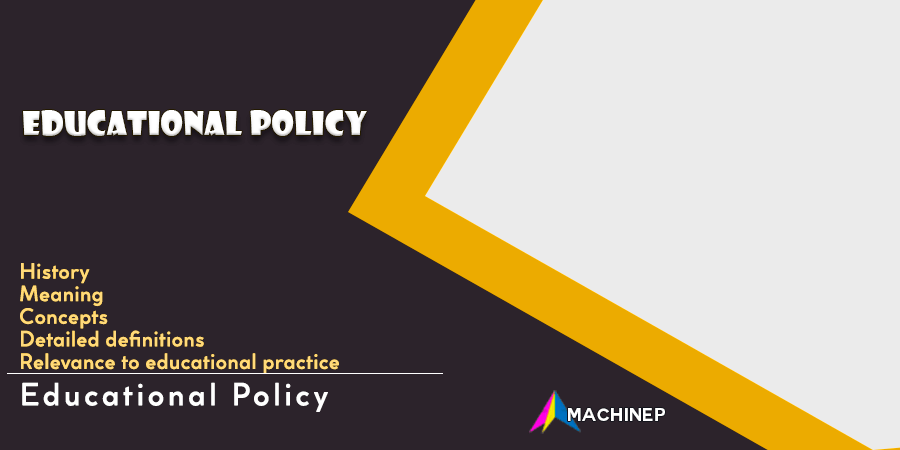Different scholars have given different meanings to the concept of policy. The concept of policy is often used interchangeably or confused as synonymous with other similar concepts, like strategy, rules, regulations, and procedures. In this fantastic article, we shall review the History of Educational Policies and their Relevance.
A policy is a guide or plan of action designed to achieve organizational goals, while strategies or procedures are the instruments that administrators employ to translate policies into a specific course of action.
Etymologically, the concept of policy is multi-rooted, but basically, it is a fourteenth-century recorded word. It comes from Latin “Politica,” representing the State, civil administration, and Greeks’ Ploliteia,” meaning State administration, government, and citizenship.
A policy is simply a government program of action or a body of principles underlying the activities of an organization.
Educational policy concerns the documentation of a definite course of action adopted by the government or its representatives on issues and problems considered expedient in education. Education policy may take the form of ordinances, codes, laws, acts, edicts, or decrees.
The Historical Development of Education Policies
The historical development of education policies has transformed from the pre-illiterate era to the present and has passed many stages. As a result, there are many policies in the annals (reports of the work of a learned body) of educational development in Nigeria.
These policies are classified according to the following stages.
- The Era of Exclusive Missionary Enterprise (1842-1900)
- The Era of Dual (Mission and Government) control of education (1900–1951)
- The Era of Regionalization in Nigeria Education (1951–1966)
- The Era of education under the military regime (1920–1999)
- The Era of post-1999 Reforms in Nigerian Education
1. The Era of Exclusive Missionary Enterprise (1842–1900)
The British masters had not colonized Nigeria as of 1842–1900. The Christian missionaries that opened and operated a school in Nigeria did so through the extension of friendship extended to them by the rules of the communities where they established schools as some of them strife complete rejections from the local people in most cases.
The Church Missionary Society (CMS) established the first secondary school in the Bariga district of Lagos, Nigeria, otherwise called CMS Grammar School, on 6th June 1859). Hope Waddell Training Institute in Calabar established the United Presbyterian Church of Scotland mission in 1895.
The Roman Catholic Mission established St. Gregory’s College, Lagos, in 1928, and Christ the King College, Onitsha, in 1933. Each mission adopted her rules of training and condition of service for her teachers until 1882 when the colonial government showed interest in educational matters through the act of various education ordinances.
The principles that guided the operations and policies of education in Nigeria during the mission era were the same, irrespective of coloration.
Christian mission’s primary purpose of education was to spread the Christian faith and convert to Christianity through education. Two ordinances were passed during this period, and they were the stepping stone to colonial education.
The 1882 Education Ordinance
Education legislation began in Nigeria by introducing the 1882 Education ordinance for British West African territories: Lagos, Gold Coast (now Ghana), Sierra Leone, and the Gambia. It prescribed the following criteria.
- Award of grant for organization and discipline, with a special grant for schools that got a high percentage of passes and thus attained a high standard of general excellence.
- A capitation grant for each subject.
- A capitation grant in proportion to the average attendance at school.
- Other provisions of the ordinance are the annual evaluation of pupils, granting teachers certificates, and a system of grant-in-aid.
- The establishment of a General Board of education with the power to establish local boards. The ordinance also recommended that one-third of the salary of the inspector of schools for the Gold Coast should be paid by the Lagos Colony. Lagos and Gold Coast were jointly administered.
The 1887 Education Ordinance
Consequent to the separation of the Lagos colony from the Gold Coast in 1886, it became mandatory that a purely Nigerian Education ordinance be enacted. Accordingly, the ordinance was enacted in 1887. Given below are the provisions of the 1887 education ordinance for the colony of Lagos.
- Grants-in-aid to schools and teacher’s training institutions.
- The power of the board to make, alter and revoke rules for regulating the procedures of grants-in-aid.
- Certificate of teachers.
- Admission into an assisted school of pauper and alien children assigned to it by the Governor.
- Establishment of scholarships for secondary and technical education.
2. The Era of Dual (Mission and Government) Control of Education (1900–1951)
In 1900, most parts of Nigeria fell under the British crown. The hallmark of this fall was the amalgamation of Southern Nigeria with the protectorate of Northern Nigeria in 1914, and Lord Frederick Lugard was appointed Governor-General of Nigeria.
Lord Lugard sought the unification of the north and the south’s education departments to pursue a uniform educational policy.
He drafted an educational ordinance that would ensure that the English Language is taught in all schools across the country and become the country’s, Lingua Franca. Some policies of this period include the following.
The 1916 Education Ordinance
The 1916 education ordinance and its education code were approved on 21st and 24th December 1916. They resulted from Lord Lugard’s efforts to cater to the whole country as education was based on moral character and usefulness to both the individual and community.
Objectives of the 1916 Education ordinance and code training on the formation of character and habits of discipline.
Co-operation between government and mission
Rural as well as Urban Education
The 1926 Education Ordinance
This ordinance was meant to increase government expenditure on education and to exercise more firm “control over educational development in Nigeria.” It provided the adaption of formal education to local conditions.
The 1948 Education Ordinance
The 1948 ordinance decentralized educational administration and created a Central Board of Education and four regional boards: East, West, Lagos, and North. It also recommended the establishment of local education committees and local education authorities.
3. The Era of Regionalization in Nigeria Education (1951 – 1959)
By 1946, Arthur Richards had become the Governor-General of Nigeria. He thus introduced a constitution after his name. The ordinance was an attempt to regionalize education in the country to create healthy rivalry among the three regions for rapid development in education.
By 1951, Sir John Macpherson became the Governor-General of Nigeria. His constitution accorded the three regions their autonomy and vested them with the power to enact and legislate the regional laws for regulating education in their various regions.
Some of the educational policies of this era include:
- The 1952 Education Ordinance: The 1952 education ordinance was introduced to enable each of the three regions to develop its educational policies and system.
- The Regional Education Law of 1954: Nigeria became a federation of three (Eastern, Western and Northern) because of the adoption of the 1954 constitution. The regions had the power of making laws for their territory and citizens. Education ordinance in 1957, the system of regional laws in education was given impetus, and these caused the birth of the Universal Primary Education (UPE) in the West in 1955.
4. The Era of Military Takeover of Education in Nigeria (1970–1999)
There was an outbreak of the Civil War between thirty months (July 1967 to 15th January 1970), which caused the destruction of schools, buildings, churches, and roads in the Eastern region, not to mention the loss of lives.
During this period, the system of education in the country was ground to a halt. Academic activities were brought to a standstill, and no significant progress was made in education. The military government of the Eastern region immediately swings into action to rescue education in the region.
She enacted the public Education Edict of 1970. By this edict, all schools owned and managed by voluntary agencies, private individuals, Christian bodies, and local government, which made up about 80% of the total existing schools, became centrally controlled.
The most significant change of the period was the government’s take-over from the missionaries by the government, resulting in a unified educational system based on the 7-5-2-3 educational policy that replaced the 8-5-2-3 educational policy.
The National Policy on Education 1977
This policy on education specifies the type and quality of instruction that should be provided to help learners at all levels of education achieve permanent literacy, numeracy, and effective citizenship. After the educational policies of the school republic, 1979–2983 follows the Education edict of 1983.
The Education Edict of 1983–1999
The Federal military government promulgated this edict to guide and regulate the conduct of education. Such include Decree No. 16 of 1985, which was on National minimum standards and establishment of institutions.
The Universal Basic Education (UBE) Scheme 1999
Nigeria returned to civilian rule in 1999 with president Olusegun Obasanjo as the country’s new president. In education, the UBE was not the first attempt of the federal government at providing free education to all its citizenry.
The UBE can be regarded as an offshoot of the universal primary education scheme, which was launched in 1976 by General Olusegun Obasanjo. UBE aimed to provide free and universal basic education for every Nigerian child of school-going age.
The Education Laws of 1999–2004
The constitution of the Federal Republic of Nigeria Decrees of 1999 states the objectives of education of Nigeria as contained in the 1979 Constitution. These objectives include the inculcation of national consciousness and unity, the training of the mind in the world’s understanding, and the inculcation of the right values and attitudes for the survival of the individual and the Nigerian society.
5. The Era of Post 1999 Reforms in Nigerian Education
Beginning in 1999, the Nigerian government has made a concerted effort at ensuring educational development in the country. Some of these reforms are:
- The 9-3-4 Education System
- Basic Education Act
- Child Right Act
- Operation Reach All Primary School (ORAPS)
- Operation Reach All Secondary School (ORASS)
- Tracking Assets for Progress (TAP)
- Adopt-A-Public School
- Vocational Enterprise Institution (VEI)
- Innovative Enterprise Institute (IEIS)
- Read to be Educated Advanced and Developed (READ)
The above reforms and initiatives in education embarked upon by the government were to stimulate national growth and development. The government, by these reforms, aims at educating all of Nigeria irrespective of age, sex, religion, occupation, and location.
The Relevance of Policies To Educational Processes and Practices
- Policies are essential to educational processes and practices because they help a school establish rules and procedures and create a standard of quality for learning and safety, expectations, and accountability. Without these, schools would lack the structure and educational needs of the students.
- Policies establish standards and help hold schools and educators accountable to the public.
- The policies are essential for relating education to the community and making it responsible to the larger world.
- Policies help determine how school operations are handled down to every minute detail so that educators, staff, and students can know what is expected and act accordingly. It saves time and prevents confusion, and unifies the school.
Conclusion
In conclusion, education policies started from the era of missionary enterprise (1842–1900) when the church missionaries came to Nigeria and established schools that made policies that govern the activities or operation of the school.
They laid the foundation of educational policies that our leaders implement into the educational system, which aid the smooth running of our educational practices.






Many thanks! I like it!
I am not real wonderful with English but I learned a lot from this.
I do agree with all of the concepts you have introduced in your post.
Interesting!
Bravo!
Your writing style marvels me… Keep it up, you’ve got another fan
I’m happy with your writing skills… I enjoyed studying with you..
These are typically genuinely wonderful ideas. You have touched some nice factors here.
Any way continue writing.
I appreciate the writer for making it detailed..
There may be certainly a great deal to understand more about this
topic. I really like all the points you made.
Incredible points. Great arguments. Keep up the good spirit.